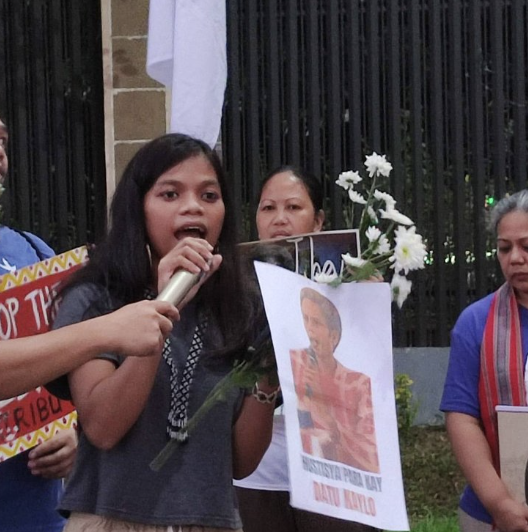By Anmol Irfan, freelance journalist
To mark the occasion of Philippines Indigenous People’s Month in August, Sabokahan, a grassroots organisation of Lumad women, issued a statement regarding their founder Bai Bibyaon Ligakay Bigkay, who passed away late last year at age 90.

Almost a year after Bai Bibyaon’s death, Sabokahan, Liyang Network – which connects indigenous activism in the Philippines to global support – and other organisations continuing Bai’s work have spent most of their time countering slander and misinformation spread through state networks that aim to disassociate Bai from her life’s mission and discredit the work these organisations are continuing.
Media coverage of indigenous voices
Their statement spoke about Sabokahan’s efforts in defending Lumad rights and lives, and amongst other things, talking about the state narrative against Bai. “Despite NTF-ELCAC’s (The National Task Force to End Local Communist Armed Conflict) efforts to twist the narrative about Sabokahan and Bai Bibyaon, there was outstanding public support, participation and celebration of the Pagpatuloy: Isabuhay ang Legasiya ni Bai Bibyaon tribute campaign. Bai’s legacy was commemorated in rallies, art exhibitions, journalism, and tribute ceremonies.”
Sabokahan and its supporters have been challenging organisations such as The Mindanao Indigenous Peoples Council of Elders and Leaders (MIPCEL), who they say are vessels for the state to use indigenous voices to make their claims seem more legitimate. MIPCEL has been using social media to issue statements saying organisations held Bai Bibyaon captive against her will. Sabokahan and Liyang Network have also been accused of keeping Bai away from her people, and that indigenous activists are associated with armed terrorists in the countryside – which is illegal in the Philippines.
These red-tagging tactics that the government has been using against indigenous Lumad activists, and against Bai’s life and work, aren’t new. Red-tagging, which is the labeling of individuals or organisations as terrorists or communists regardless of their actual political beliefs or affiliations, is a common tactic that’s been used by the Philippine government for decades, although human rights organisations believe it increased under former President Rodrigo Duterte’s government.
Freedom of expression in the Philippines
Journalists in the Philippines often face danger due to private militia’s attempts to silence them, which makes the efforts of these activists and groups – who want to challenge the state narrative – that much more dangerous. Activists face a very similar threat. “We can’t go outside without worrying about our security because they [militias] can abduct us anywhere. Enforced disappearances happen a lot here in the Philippines,” Kat Dalon, Vice Chair of Sabokahan Youth, tells MDI.
Pau Pena a full-time organiser with Liyang Network from Ecuador and Education Officer of their US chapter who joined the movement before Liyang was officially founded, said that even schools in Mindanao, where the Lumad people live, were under threat by paramilitary forces. The threat has forced activists to move and create temporary schools, called Bakwit (evacuate) schools, in evacuation centres, where the Lumad community took refuge from military occupation.
The power of social media and its global impact
Pau tells MDI that “Facebook is free in the Philippines with people’s phone plans, and black propaganda is very common there. Traditional media unquestioningly repeats what the government is saying.”
In comparison, Sabokahan reaches out to people through social media and by calling on global allies to highlight their activism. The story of Bai Bibyaon is not specific to her alone. It is the story of women activists across Southeast Asia, and in many ways across the globe – as women of colour have long been targeted by their governments for speaking out as activists and changemakers and demanding the rights their communities deserve.
Sabokahan’s social media strategy has been successful. Dalon says that their campaigns involve a mix of education, solidarity and keeping up with trends such as making videos like “I’m a Lumad woman, of course we defend our land…”.
“It has a positive impact for us because people share our videos and many people would have heard about our organisation. Through our work, they are encouraged to know about Bai Bibyaon, and the government doesn’t have the reach we do on social media,” Dalon tells MDI.
Dalon further asks international media to share Bai’s story and to highlight Sabokahan’s efforts in their work, because their struggle is a global one. She wants more people to know about the Lumad struggle and look beyond the government’s narrative that seeks to malign the generations worth of work Sabokahan and Bai Bibyaon have done in educating and empowering Lumad women.
“Globally it’s a story of women empowerment and staying true to your ideals,” Pau says. “The goal of international media calls is just to tell the truth, what’s the reality, what’s the reason. The government just wants to tell a superficial story, and we want to show the causes and who’s actually responsible for why people need sanctuary and evacuation schools in the first place.”
Bai’s undeniable impact and legacy left the government unable to target her actions directly, and those continuing her work hope that by showing people the truth and using the power of media they will have a positive effect. By highlighting the voices of those directly impacted, they can show people the truth behind these campaigns and spread a more honest understanding of the struggle of Lumad activists. Sabokahan’s struggle is a lesson on the power of social media and global impact.
Pictures from Sabokahan website: https://www.sabokahan.org/
Disclaimer:
The views and opinions expressed in this article are solely those of the author and do not reflect the official policy or position of the Media Diversity Institute. Any question or comment should be addressed to [email protected]
